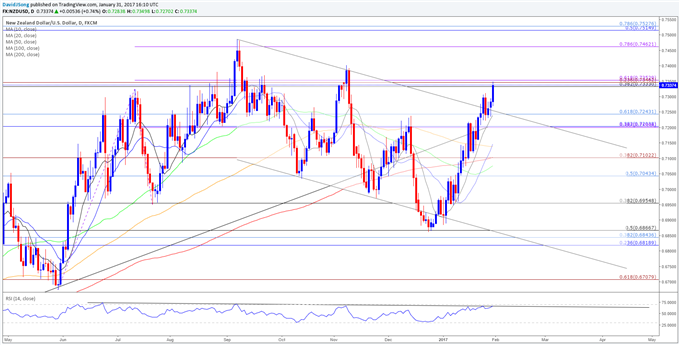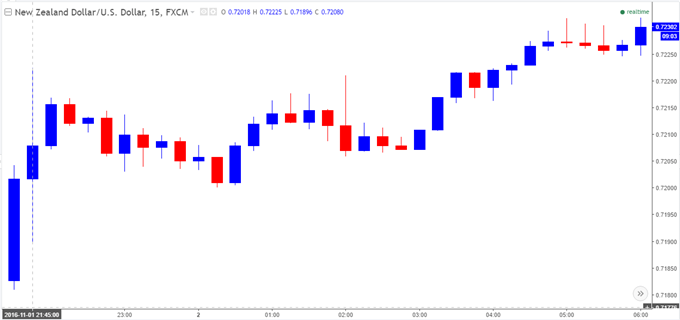
Stronger New Zealand Job/Wage Growth to Fuel NZD/USD Breakout
Stronger New Zealand Job/Wage Growth to Fuel NZD/USD Breakout
- New Zealand to Increase 6.1% for Second Straight Quarter.
- Private Wage ex. Overtime to Pick Up for First Time Since 2Q 2015.
Trading the News: New Zealand Employment
A downtick in the jobless rate paired with another 6.1% expansion in New Zealand Employment may fuel the near-term advance in NZD/USD especially as household earnings are projected to increase for the first time since the second quarter of 2015.
What’s Expected:

Why Is This Event Important:After cutting the official cash rate to a fresh record-low of 1.75% at the last policy meeting for 2016, the Reserve Bank of New Zealand (RBNZ) may endorse a wait-and-see approach for the foreseeable future as ‘numerous uncertainties remain, particularly in respect of the international outlook,’ but signs of stronger job & wage growth may push Governor Graeme Wheeler to move away from the dovish stance as ‘annual inflation is expected to rise from the December quarter, reflecting the policy stimulus to date, the strength of the domestic economy, and reduced drag from tradables inflation.’
Expectations: BullishArgument/Scenario
Release | Expected | Actual |
Trade Balance (NZD) (DEC) | -98M | -41M |
ANZ Business Confidence (DEC) | -- | 21.7 |
Manufacturing Activity s.a. (2Q) | -- | 2.2% |
The improvement in the terms of trade accompanied by the pickup in business outputs may foster a stronger-than-expected employment report, and a further improvement in labor market dynamics may heighten the appeal of the New Zealand dollar as it puts pressure on the RBNZ to move away from its easing-cycle.
Risk:BearishArgument/Scenario
Release | Expected | Actual |
Building Permits (NOV) | -- | -9.2% |
REINZ House Sales (YoY) (DEC) | -- | -10.7% |
Money Supply M3 (YoY) (NOV) | -- | 5.9% |
However,easing home sales along with the slowdown in building activity may drag on hiring, and a dismal development may produce near-term headwinds for the New Zealand dollar as it drags on interest rate expectations.
How To Trade This Event Risk
Bullish NZD Trade: Employment Expands 6.1%, Wage Growth Picks Up
- Need green, five-minute candle following the release to consider a long NZD/USD position.
- If market reaction favors a bullish kiwi trade, buy NZD/USD with two separate position.
- Set stop at the near-by swing low/reasonable distance from cost; at least 1:1 risk-to-reward.
- Move stop to entry on remaining position once initial target is met, set reasonable limit.
Bearish NZD Trade: New Zealand Labor Report Disappoints
- Need red, five-minute candle to favor a short NZD/USD trade.
- Implement same strategy as the bullish New Zealand dollar trade, just in reverse.
Potential Price Targets For The Release
NZD/USD Daily

- With NZD/USD breaking out of the downward trending channel carried over from the previous year, a break/close above the near-term hurdle around 0.7330 (38.2% retracement) to 0.7350 (61.8% expansion) may highlight a shift in the broader outlook especially as the Relative Strength Index (RSI) shows a similar dynamic and threatens the bearish formation from June; a break of trendline resistance may open up the November high (0.7403) followed by the September high (0.7485).
- InterimResistance:0.7515 (50% retracement) to 0.7530 (78.6% retracement)
- InterimSupport:0.6885 (2017 low) to 0.6950 (38.2% retracement)
Impact that the New Zealand Employment report has had on NZD/USD during the last release
Period | Data Released | Estimate | Actual | Pips Change (1 Hour post event ) | Pips Change (End of Day post event) |
3Q 2016 | 11/10/2016 21:45 GMT | 5.4% | 6.1% | +5 | +85 |
3Q 2016 New Zealand Employment
NZD/USD 15-Minute

New Zealand Employment increased an annualized 6.1% during the three-months through September, with the jobless rate narrowing to 4.9% per annum from a revised 5.0% in the second quarter, while the labor force participation rate advanced to 70.1% amid forecasts for a 69.7% print. Despite the pickup in job growth, Private Wages excluding Overtime held steady at an annualized 0.4% for the fifth consecutive quarter, and the Reserve Bank of New Zealand (RBNZ) may preserve the record-low interest rate throughout 2017 in an effort to combat the ongoing weakness in household earnings. The New Zealand dollar gained ground following the improvement in labor market dynamics, with NZD/USD climbing above the 0.7225 region to end the day at 0.7287.



